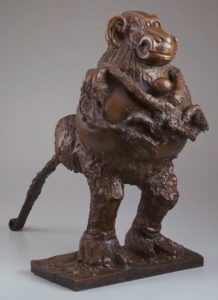By LILIANA GIL, 4/25/2016. “Baboon and Young (1951) shows Picasso’s power of metaphorical transformation at its height. Now please look closer…” I stopped paying attention to the audio guide. Here I was in MOMA, trying to navigate a room swarmed with visitors speaking many different languages, and despite all the bustle and buzz I felt a pause, a little suspension. An unexpected giggle took over me.
Picasso is known for his love of animals, but as far as I know he never had a baboon. He had, however, a little Claude, who filled his world with games and child paraphernalia. Using two toy cars, one upright, other upside down, Picasso perceptively composed the face of a primate. Framed by two protuberant ears made of cup handles, the striated car hoods became an amusing snout under the windshield eyes. In the back, a car spring was made to stem from the body-jug in the shape of a tail that helps support the bronze sculpture’s weight.
Assembling familiar objects into new possibilities, Baboon and Young plays the line between the artist and the hacker, reminding us that forms of resourceful repurposing exist everywhere. And yet, these practices can be recognized and valorized in very different ways depending on a number of circumstantial factors, such as their institutional framings, the functions they achieve, our expectations about their authors’ creative abilities, or the materials involved.
If that baboon I saw is not jugaad, what separates the two?

